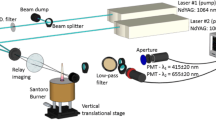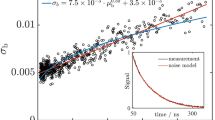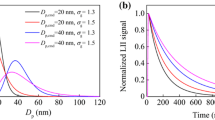Abstract
Time-resolved laser-induced incandescence for primary particle size determination is tested using three model carbon blacks. Optical properties change as does the nanostructure upon laser annealing, whereas aggregate morphology and primary particle size remain equivalent to the original material, as shown by transmission electron microscopy (TEM). Primary particle diameters found from fitting experimentally measured time-resolved laser-induced incandescence (LII) signals with existing models do not match the particle diameters as directly visualized by TEM. The accommodation coefficient is shown to be a crucial parameter which can result in substantial variations in simulated conductive cooling profiles for particle sizing. Aggregate structure in the form of intra-aggregate connectivity and shielding is an additional underlying cause for erroneous particle sizing, not presently captured by LII models.


















Similar content being viewed by others
Abbreviations
- IR:
-
Infra-red
- HOMO:
-
Highest occupied molecular orbital
- LUMO:
-
Lowest unoccupied molecular orbital
- LII:
-
Laser-induced Incandescence
- NIR:
-
Near infra-red
- RDG-FA:
-
Rayleigh–Debye–Gans approximation for fractal aggregates
- TEM:
-
Transmission electron microscopy
- TTH:
-
Time–temperature history
- UV:
-
Ultraviolet
- YAG:
-
Yttrium aluminum garnet
- C :
-
Heat capacity, J/mol K
- d p :
-
Primary particle diameter, nm
- E g :
-
Optical band gap, eV
- E(m) :
-
Index of refraction function
- h :
-
Planck’s constant, 6.626 × 10−34 m2 kg/s
- t :
-
time, s
- T :
-
Temperature, K
- α :
-
Thermal accommodation coefficient
- π :
-
pi, 3.1415926
- ρ :
-
Density, g/cm3
- λ :
-
Wavelength, nm
- Ʌ :
-
Heat transfer coefficient, W/m2 K
- σ abs :
-
Absorption cross-section
- ν :
-
Frequency of incident radiation, Hz
References
H.A. Michelsen, Probing soot formation, chemical and physical evolution, and oxidation: a review of in situ diagnostic techniques and needs. Proc. Combust. Inst. 36, 717–735 (2017)
H.A. Michelsen, C. Schulz, G.J. Smallwood, S. Will, Laser-induced incandescence: Particulate diagnostics for combustion, atmospheric, and industrial applications. Prog. Energy Combust. Sci. 51, 2–48 (2015)
R.L. Vander Wal, M.Y. Choi, Pulsed laser heating of soot: morphological changes. Carbon 37, 231–239 (1999)
R.L. Vander Wal, T.M. Ticich, A. Brock Stephens, Can soot primary particle size be determined using laser-induced incandescence? Combust. Flame 116, 291–296 (1999)
H.A. Michelsen et al., Modeling laser-induced incandescence of soot: enthalpy changes during sublimation, conduction, and oxidation. Appl. Phys. B Lasers Opt. 93, 645–656 (2008)
T.L. Farias, ÜÖ Köylü, M.G. Carvalho, Range of validity of the Rayleigh–Debye–Gans theory for optics of fractal aggregates. Appl. Opt. 35, 6560–6567 (1996)
H.A. Michelsen et al., Modeling laser-induced incandescence of soot: a summary and comparison of LII models. Appl. Phys. B 87, 503–521 (2007)
R.L. Vander Wal, Laser-induced incandescence: excitation and detection conditions, material transformations and calibration. Appl. Phys. B 96, 601–611 (2009)
X. López-Yglesias, P.E. Schrader, H.A. Michelsen, Soot maturity and absorption cross sections. J. Aerosol Sci. 75, 43–64 (2014)
H.A. Michelsen, Understanding and predicting the temporal response of laser-induced incandescence from carbonaceous particles. J. Chem. Phys. 118, 7012–7045 (2003)
E. Cenker, W.L. Roberts, Quantitative effects of rapid heating on soot-particle sizing through analysis of two-pulse LII. Appl. Phys. B 123, 74 (2017)
F. Goulay, P.E. Schrader, H.A. Michelsen, Effect of the wavelength dependence of the emissivity on inferred soot temperatures measured by spectrally resolved laser-induced incandescence. Appl. Phys. B 100, 655–663 (2010)
H.A. Michelsen, P.E. Schrader, F. Goulay, Wavelength and temperature dependences of the absorption and scattering cross sections of soot. Carbon 48, 2175–2191 (2010)
K.C. Smyth, C.R. Shaddix, The elusive history of m = 1.57–0.56i for the refractive index of soot. Combust. Flame 107, 314–320 (1996)
R.L. Vander Wal, T.M. Ticich, A.B. Stephens, Optical and microscopy investigations of soot structure alterations by laser-induced incandescence. Appl. Phys. B Lasers Opt. 67, 115 (1998)
C. Jäger, T. Henning, R. Schlögl, O. Spillecke, Spectral properties of carbon black. J. Non Cryst. Solids 258, 161–179 (1999)
J.P. Abrahamson, Pulsed laser annealing of carbon (The Pennsylvania State University, State College, 2017)
K.A. Thomson, K.P. Geigle, M. Köhler, G.J. Smallwood, D.R. Snelling, Optical properties of pulsed laser heated soot. Appl. Phys. B 104, 307–319 (2011)
F. Goulay, P.E. Schrader, X. López-Yglesias, H.A. Michelsen, A data set for validation of models of laser-induced incandescence from soot: temporal profiles of LII signal and particle temperature. Appl. Phys. B 112, 287–306 (2013)
B. Apicella, M. Alfè, R. Barbella, A. Tregrossi, A. Ciajolo, Aromatic structures of carbonaceous materials and soot inferred by spectroscopic analysis. Carbon 42, 1583–1589 (2004)
D.E. Rosner, P. Tandon, Prediction and correlation of accessible area of large multiparticle aggregates. AIChE J. 40, 1167–1182 (1994)
A.V. Filippov, M. Zurita, D.E. Rosner, Fractal-like aggregates: relation between morphology and physical properties. J. Colloid Interface Sci. 229, 261–273 (2000)
C.M. Sorensen, Light scattering by fractal aggregates: a review. Aerosol Sci. Technol. 35, 648–687 (2001)
F. Liu, G.J. Smallwood, D.R. Snelling, Effects of primary particle diameter and aggregate size distribution on the temperature of soot particles heated by pulsed lasers. J. Quant. Spectrosc. Radiat. Transf. 93, 301–312 (2005)
F. Liu, B.J. Stagg, D.R. Snelling, G.J. Smallwood, Effects of primary soot particle size distribution on the temperature of soot particles heated by a nanosecond pulsed laser in an atmospheric laminar diffusion flame. Int. J. Heat Mass Transf. 49, 777–788 (2006)
R.P. Bambha, H.A. Michelsen, Effects of aggregate morphology and size on laser-induced incandescence and scattering from black carbon (mature soot). J. Aerosol Sci. 88, 159–181 (2015)
H. Bladh et al., Probing the smallest soot particles in low-sooting premixed flames using laser-induced incandescence. Proc. Combust. Inst. 35, 1843–1850 (2015)
R. Bambha, M. Dansson, P. Schrader, H. Michelsen, Effects of volatile coatings on the laser-induced incandescence of soot. Appl. Phys. B Lasers Opt. 112, 343–358 (2013)
S.-A. Kuhlmann, J. Reimann, S. Will, On heat conduction between laser-heated nanoparticles and a surrounding gas. J. Aerosol Sci. 37, 1696–1716 (2006)
H.A. Michelsen, Derivation of a temperature-dependent accommodation coefficient for use in modeling laser-induced incandescence of soot. Appl. Phys. B 94, 103 (2008)
F.O. Goodman, Thermal accommodation coefficients. J. Phys. Chem. 84, 1431–1445 (1980)
H. Bladh, J. Johnsson, P.-E. Bengtsson, Influence of spatial laser energy distribution on evaluated soot particle sizes using two-colour laser-induced incandescence in a flat premixed ethylene/air flame. Appl. Phys. B Lasers Opt. 96, 645–656 (2009)
J.P. Abrahamson, M. Singh, J.P. Mathews, R.L. Vander Wal, Pulsed laser annealing of carbon black. Carbon 124, 380–390 (2017)
S. Schraml, S. Dankers, K. Bader, S. Will, A. Leipertz, Soot temperature measurements and implications for time-resolved laser-induced incandescence (TIRE-LII). Combust. Flame 120, 439–450 (2000)
M. Hofmann, B. Kock, C. Schulz, A web-based interface for modeling laser-induced incandescence (LIISim). in Proc. Eur. Combust. Meet (2007)
B.J. McCoy, C.Y. Cha, Transport phenomena in the rarefied gas transition regime. Chem. Eng. Sci. 29, 381–388 (1974)
N.A. Fuchs, On the stationary charge distribution on aerosol particles in a bipolar ionic atmosphere. Geofis. Pura e Appl. 56, 185–193 (1963)
F. Liu, M. Yang, F.A. Hill, D.R. Snelling, G.J. Smallwood, Influence of polydisperse distributions of both primary particle and aggregate size on soot temperature in low-fluence LII. Appl. Phys. B 83, 383 (2006)
S. Will, S. Schraml, K. Bader, A. Leipertz, Performance characteristics of soot primary particle size measurements by time-resolved laser-induced incandescence. Appl. Opt. 37, 5647–5658 (1998)
R. Mansmann et al., LIISim: a modular signal processing toolbox for laser-induced incandescence measurements. Appl. Phys. B 124, 69 (2018)
E. Cenker, G. Bruneaux, T. Dreier, C. Schulz, Determination of small soot particles in the presence of large ones from time-resolved laser-induced incandescence. Appl. Phys. B 118, 169–183 (2014)
H.A. Michelsen et al., Particle formation from pulsed laser irradiation of soot aggregates studied with a scanning mobility particle sizer, a transmission electron microscope, and a scanning transmission X-ray microscope. Appl. Opt. 46, 959–977 (2007)
W.D. Bachalo, S.V. Sankar, G.J. Smallwood, D.R. Snelling, Development of the laser-induced incandescence method for the reliable characterization of particulate emissions. in Proc. 11th Int. Symp. Appl. Laser Tech. to Fluid Mech. (2002)
J. Johnsson, H. Bladh, N.-E. Olofsson, P.-E. Bengtsson, Influence of soot aggregate structure on particle sizing using laser-induced incandescence: importance of bridging between primary particles. Appl. Phys. B Lasers Opt. 112, 321–332 (2013)
H. Bladh et al., Influence of soot particle aggregation on time-resolved laser-induced incandescence signals. Appl. Phys. B 104, 331–341 (2011)
M. Schnaiter et al., UV–Vis–NIR spectral optical properties of soot and soot-containing aerosols. J. Aerosol Sci. 34, 1421–1444 (2003)
S. Bejaoui, R. Lemaire, P. Desgroux, E. Therssen, Experimental study of the E(m, λ)/E(m, 1064) ratio as a function of wavelength, fuel type, height above the burner and temperature. Appl. Phys. B 116, 313–323 (2014)
U.O. Köylü, G.M. Faeth, Radiative properties of flame-generated soot. J. Heat Transf. 115, 409–417 (1993)
G. Cléon, T. Amodeo, A. Faccinetto, P. Desgroux, Laser induced incandescence determination of the ratio of the soot absorption functions at 532 nm and 1064 nm in the nucleation zone of a low pressure premixed sooting flame. Appl. Phys. B Lasers Opt. 104, 297–305 (2011)
J. Simonsson, N.-E. Olofsson, S. Török, P.-E. Bengtsson, H. Bladh, Wavelength dependence of extinction in sooting flat premixed flames in the visible and near-infrared regimes. Appl. Phys. B Lasers Opt. 119, 657–667 (2015)
P. Minutolo, G. Gambi, A. D’Alessio, The optical band gap model in the interpretation of the UV-visible absorption spectra of rich premixed flames. in Twenty-Sixth International Symposium on Combustion, vols. 1 and 2 (Combustion Institute, 1996), pp. 951–957
J. Tauc, R. Grigorovici, A. Vancu, Optical properties and electronic structure of amorphous germanium. Phys. Status Solidi 15, 627–637 (1966)
J.H. Miller, J.D. Herdman, C.D.O. Green, E.M. Webster, Experimental and computational determinations of optical band gaps for PAH and soot in a N2-diluted, ethylene/air non-premixed flame. Proc. Combust. Inst. 34, 3669–3675 (2013)
E.M. Adkins, J.H. Miller, Extinction measurements for optical band gap determination of soot in a series of nitrogen-diluted ethylene/air non-premixed flames. Phys. Chem. Chem. Phys. 17, 2686–2695 (2015)
J. Robertson, E.P. O’Reilly, Electronic and atomic structure of amorphous carbon. Phys. Rev. B 35, 2946–2957 (1987)
A.C. Eckbreth, Laser Diagnostics for Combustion Temperature and Species (Gordon and Breach Science Publishers, Amsterdam, 1996)
Acknowledgements
The authors acknowledge support by the National Science Foundation (NSF), Chemical, Bioengineering, Environmental, and Transport Systems (CBET), under Grant number 1236757. TEM was performed using the facilities of the Materials Research Institute at The Pennsylvania State University. Guidance and support on using LIISim and LIISim 3.0 provided by Raphael Mansmann is much appreciated.
Author information
Authors and Affiliations
Corresponding author
Electronic supplementary material
Below is the link to the electronic supplementary material.
Rights and permissions
About this article
Cite this article
Singh, M., Abrahamson, J.P. & Vander Wal, R.L. Informing TiRe-LII assumptions for soot nanostructure and optical properties for estimation of soot primary particle diameter. Appl. Phys. B 124, 130 (2018). https://doi.org/10.1007/s00340-018-6994-x
Received:
Accepted:
Published:
DOI: https://doi.org/10.1007/s00340-018-6994-x




